Strategic Planning for Coach House Hotel - Hospitality Report
VerifiedAdded on 2020/01/07
|13
|4881
|203
Report
AI Summary
This report provides a strategic analysis of the Coach House Hotel, a well-established accommodation provider. It begins with an introduction outlining the hotel's current situation and its need for strategic solutions, particularly expansion and service diversification. The report then conducts a thorough examination of external and internal factors influencing the hotel's performance, including a PESTEL analysis of political, economic, social, technological, environmental, and legal factors. It also includes a Porter's Five Forces analysis to assess competitive dynamics and a SWOT analysis to identify strengths, weaknesses, opportunities, and threats. Finally, the report explores various strategic options for the hotel, including expansion and downsizing strategies and alternative implementation methods, concluding with a discussion of strategy implementation and evaluation. This report aims to provide a comprehensive strategic plan for the hotel to achieve its objectives.
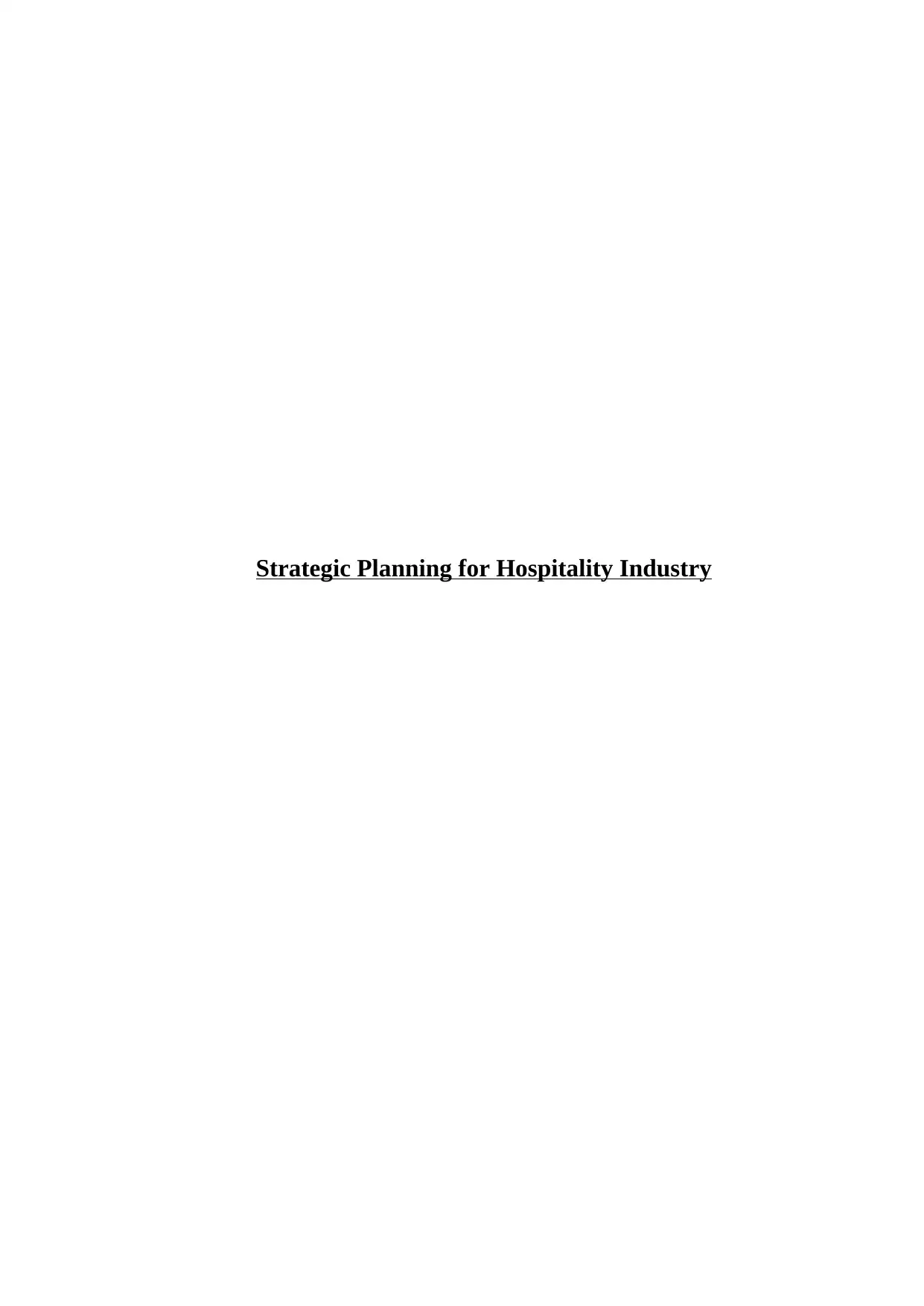
Strategic Planning for Hospitality Industry
Paraphrase This Document
Need a fresh take? Get an instant paraphrase of this document with our AI Paraphraser
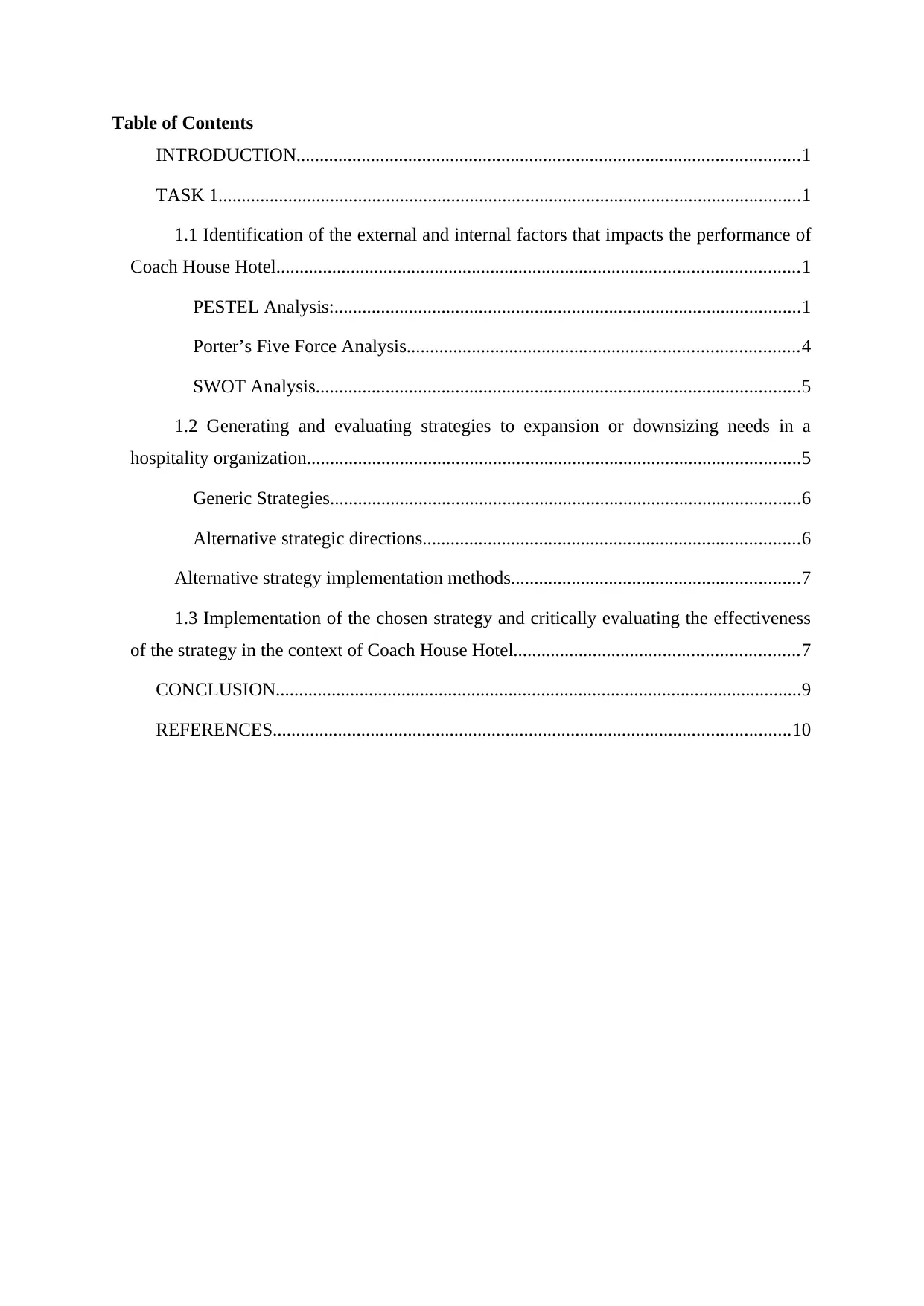
Table of Contents
INTRODUCTION............................................................................................................1
TASK 1.............................................................................................................................1
1.1 Identification of the external and internal factors that impacts the performance of
Coach House Hotel................................................................................................................1
PESTEL Analysis:....................................................................................................1
Porter’s Five Force Analysis....................................................................................4
SWOT Analysis........................................................................................................5
1.2 Generating and evaluating strategies to expansion or downsizing needs in a
hospitality organization..........................................................................................................5
Generic Strategies.....................................................................................................6
Alternative strategic directions.................................................................................6
Alternative strategy implementation methods..............................................................7
1.3 Implementation of the chosen strategy and critically evaluating the effectiveness
of the strategy in the context of Coach House Hotel.............................................................7
CONCLUSION.................................................................................................................9
REFERENCES...............................................................................................................10
INTRODUCTION............................................................................................................1
TASK 1.............................................................................................................................1
1.1 Identification of the external and internal factors that impacts the performance of
Coach House Hotel................................................................................................................1
PESTEL Analysis:....................................................................................................1
Porter’s Five Force Analysis....................................................................................4
SWOT Analysis........................................................................................................5
1.2 Generating and evaluating strategies to expansion or downsizing needs in a
hospitality organization..........................................................................................................5
Generic Strategies.....................................................................................................6
Alternative strategic directions.................................................................................6
Alternative strategy implementation methods..............................................................7
1.3 Implementation of the chosen strategy and critically evaluating the effectiveness
of the strategy in the context of Coach House Hotel.............................................................7
CONCLUSION.................................................................................................................9
REFERENCES...............................................................................................................10
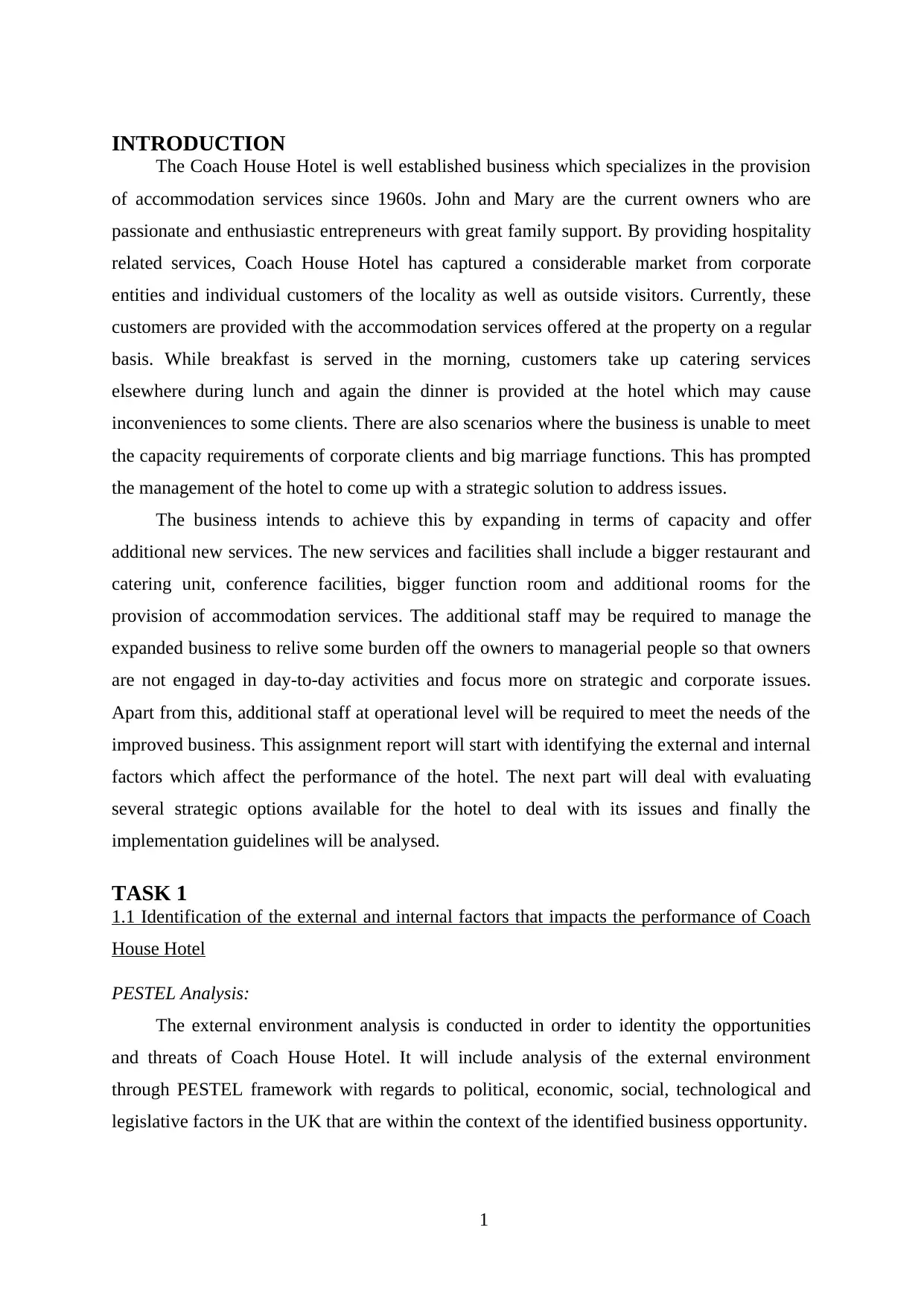
INTRODUCTION
The Coach House Hotel is well established business which specializes in the provision
of accommodation services since 1960s. John and Mary are the current owners who are
passionate and enthusiastic entrepreneurs with great family support. By providing hospitality
related services, Coach House Hotel has captured a considerable market from corporate
entities and individual customers of the locality as well as outside visitors. Currently, these
customers are provided with the accommodation services offered at the property on a regular
basis. While breakfast is served in the morning, customers take up catering services
elsewhere during lunch and again the dinner is provided at the hotel which may cause
inconveniences to some clients. There are also scenarios where the business is unable to meet
the capacity requirements of corporate clients and big marriage functions. This has prompted
the management of the hotel to come up with a strategic solution to address issues.
The business intends to achieve this by expanding in terms of capacity and offer
additional new services. The new services and facilities shall include a bigger restaurant and
catering unit, conference facilities, bigger function room and additional rooms for the
provision of accommodation services. The additional staff may be required to manage the
expanded business to relive some burden off the owners to managerial people so that owners
are not engaged in day-to-day activities and focus more on strategic and corporate issues.
Apart from this, additional staff at operational level will be required to meet the needs of the
improved business. This assignment report will start with identifying the external and internal
factors which affect the performance of the hotel. The next part will deal with evaluating
several strategic options available for the hotel to deal with its issues and finally the
implementation guidelines will be analysed.
TASK 1
1.1 Identification of the external and internal factors that impacts the performance of Coach
House Hotel
PESTEL Analysis:
The external environment analysis is conducted in order to identity the opportunities
and threats of Coach House Hotel. It will include analysis of the external environment
through PESTEL framework with regards to political, economic, social, technological and
legislative factors in the UK that are within the context of the identified business opportunity.
1
The Coach House Hotel is well established business which specializes in the provision
of accommodation services since 1960s. John and Mary are the current owners who are
passionate and enthusiastic entrepreneurs with great family support. By providing hospitality
related services, Coach House Hotel has captured a considerable market from corporate
entities and individual customers of the locality as well as outside visitors. Currently, these
customers are provided with the accommodation services offered at the property on a regular
basis. While breakfast is served in the morning, customers take up catering services
elsewhere during lunch and again the dinner is provided at the hotel which may cause
inconveniences to some clients. There are also scenarios where the business is unable to meet
the capacity requirements of corporate clients and big marriage functions. This has prompted
the management of the hotel to come up with a strategic solution to address issues.
The business intends to achieve this by expanding in terms of capacity and offer
additional new services. The new services and facilities shall include a bigger restaurant and
catering unit, conference facilities, bigger function room and additional rooms for the
provision of accommodation services. The additional staff may be required to manage the
expanded business to relive some burden off the owners to managerial people so that owners
are not engaged in day-to-day activities and focus more on strategic and corporate issues.
Apart from this, additional staff at operational level will be required to meet the needs of the
improved business. This assignment report will start with identifying the external and internal
factors which affect the performance of the hotel. The next part will deal with evaluating
several strategic options available for the hotel to deal with its issues and finally the
implementation guidelines will be analysed.
TASK 1
1.1 Identification of the external and internal factors that impacts the performance of Coach
House Hotel
PESTEL Analysis:
The external environment analysis is conducted in order to identity the opportunities
and threats of Coach House Hotel. It will include analysis of the external environment
through PESTEL framework with regards to political, economic, social, technological and
legislative factors in the UK that are within the context of the identified business opportunity.
1
⊘ This is a preview!⊘
Do you want full access?
Subscribe today to unlock all pages.

Trusted by 1+ million students worldwide
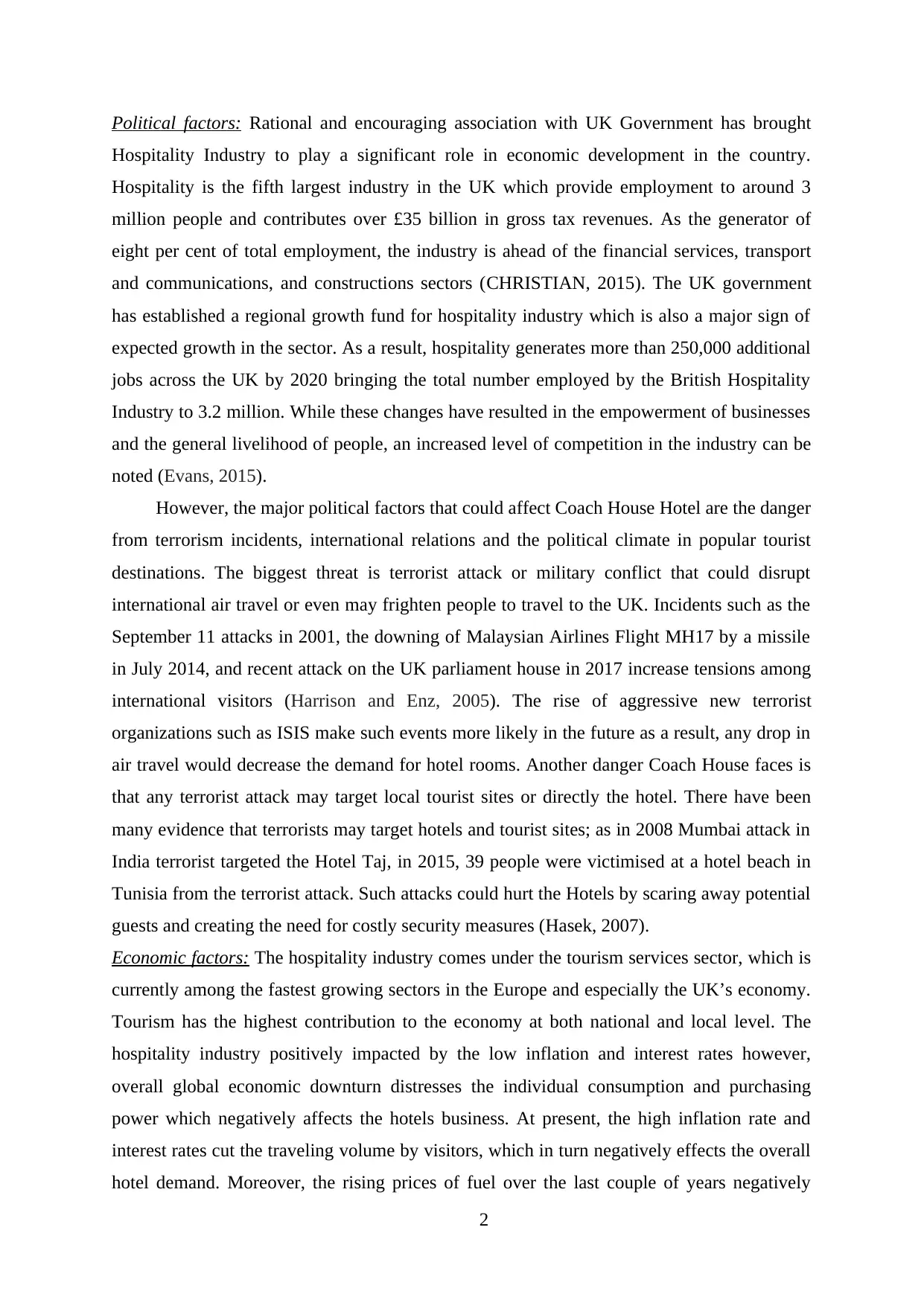
Political factors: Rational and encouraging association with UK Government has brought
Hospitality Industry to play a significant role in economic development in the country.
Hospitality is the fifth largest industry in the UK which provide employment to around 3
million people and contributes over £35 billion in gross tax revenues. As the generator of
eight per cent of total employment, the industry is ahead of the financial services, transport
and communications, and constructions sectors (CHRISTIAN, 2015). The UK government
has established a regional growth fund for hospitality industry which is also a major sign of
expected growth in the sector. As a result, hospitality generates more than 250,000 additional
jobs across the UK by 2020 bringing the total number employed by the British Hospitality
Industry to 3.2 million. While these changes have resulted in the empowerment of businesses
and the general livelihood of people, an increased level of competition in the industry can be
noted (Evans, 2015).
However, the major political factors that could affect Coach House Hotel are the danger
from terrorism incidents, international relations and the political climate in popular tourist
destinations. The biggest threat is terrorist attack or military conflict that could disrupt
international air travel or even may frighten people to travel to the UK. Incidents such as the
September 11 attacks in 2001, the downing of Malaysian Airlines Flight MH17 by a missile
in July 2014, and recent attack on the UK parliament house in 2017 increase tensions among
international visitors (Harrison and Enz, 2005). The rise of aggressive new terrorist
organizations such as ISIS make such events more likely in the future as a result, any drop in
air travel would decrease the demand for hotel rooms. Another danger Coach House faces is
that any terrorist attack may target local tourist sites or directly the hotel. There have been
many evidence that terrorists may target hotels and tourist sites; as in 2008 Mumbai attack in
India terrorist targeted the Hotel Taj, in 2015, 39 people were victimised at a hotel beach in
Tunisia from the terrorist attack. Such attacks could hurt the Hotels by scaring away potential
guests and creating the need for costly security measures (Hasek, 2007).
Economic factors: The hospitality industry comes under the tourism services sector, which is
currently among the fastest growing sectors in the Europe and especially the UK’s economy.
Tourism has the highest contribution to the economy at both national and local level. The
hospitality industry positively impacted by the low inflation and interest rates however,
overall global economic downturn distresses the individual consumption and purchasing
power which negatively affects the hotels business. At present, the high inflation rate and
interest rates cut the traveling volume by visitors, which in turn negatively effects the overall
hotel demand. Moreover, the rising prices of fuel over the last couple of years negatively
2
Hospitality Industry to play a significant role in economic development in the country.
Hospitality is the fifth largest industry in the UK which provide employment to around 3
million people and contributes over £35 billion in gross tax revenues. As the generator of
eight per cent of total employment, the industry is ahead of the financial services, transport
and communications, and constructions sectors (CHRISTIAN, 2015). The UK government
has established a regional growth fund for hospitality industry which is also a major sign of
expected growth in the sector. As a result, hospitality generates more than 250,000 additional
jobs across the UK by 2020 bringing the total number employed by the British Hospitality
Industry to 3.2 million. While these changes have resulted in the empowerment of businesses
and the general livelihood of people, an increased level of competition in the industry can be
noted (Evans, 2015).
However, the major political factors that could affect Coach House Hotel are the danger
from terrorism incidents, international relations and the political climate in popular tourist
destinations. The biggest threat is terrorist attack or military conflict that could disrupt
international air travel or even may frighten people to travel to the UK. Incidents such as the
September 11 attacks in 2001, the downing of Malaysian Airlines Flight MH17 by a missile
in July 2014, and recent attack on the UK parliament house in 2017 increase tensions among
international visitors (Harrison and Enz, 2005). The rise of aggressive new terrorist
organizations such as ISIS make such events more likely in the future as a result, any drop in
air travel would decrease the demand for hotel rooms. Another danger Coach House faces is
that any terrorist attack may target local tourist sites or directly the hotel. There have been
many evidence that terrorists may target hotels and tourist sites; as in 2008 Mumbai attack in
India terrorist targeted the Hotel Taj, in 2015, 39 people were victimised at a hotel beach in
Tunisia from the terrorist attack. Such attacks could hurt the Hotels by scaring away potential
guests and creating the need for costly security measures (Hasek, 2007).
Economic factors: The hospitality industry comes under the tourism services sector, which is
currently among the fastest growing sectors in the Europe and especially the UK’s economy.
Tourism has the highest contribution to the economy at both national and local level. The
hospitality industry positively impacted by the low inflation and interest rates however,
overall global economic downturn distresses the individual consumption and purchasing
power which negatively affects the hotels business. At present, the high inflation rate and
interest rates cut the traveling volume by visitors, which in turn negatively effects the overall
hotel demand. Moreover, the rising prices of fuel over the last couple of years negatively
2
Paraphrase This Document
Need a fresh take? Get an instant paraphrase of this document with our AI Paraphraser
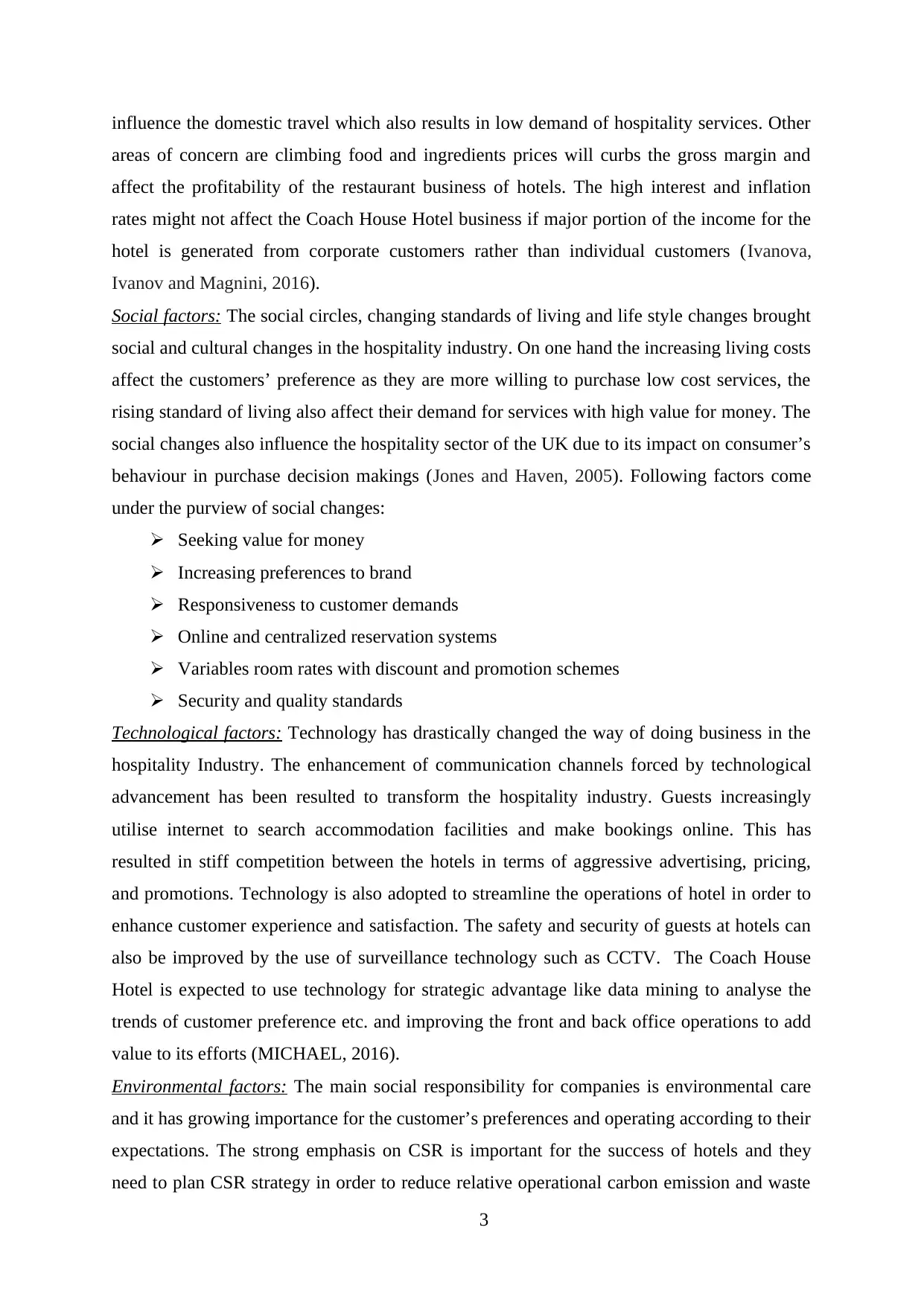
influence the domestic travel which also results in low demand of hospitality services. Other
areas of concern are climbing food and ingredients prices will curbs the gross margin and
affect the profitability of the restaurant business of hotels. The high interest and inflation
rates might not affect the Coach House Hotel business if major portion of the income for the
hotel is generated from corporate customers rather than individual customers (Ivanova,
Ivanov and Magnini, 2016).
Social factors: The social circles, changing standards of living and life style changes brought
social and cultural changes in the hospitality industry. On one hand the increasing living costs
affect the customers’ preference as they are more willing to purchase low cost services, the
rising standard of living also affect their demand for services with high value for money. The
social changes also influence the hospitality sector of the UK due to its impact on consumer’s
behaviour in purchase decision makings (Jones and Haven, 2005). Following factors come
under the purview of social changes:
Seeking value for money
Increasing preferences to brand
Responsiveness to customer demands
Online and centralized reservation systems
Variables room rates with discount and promotion schemes
Security and quality standards
Technological factors: Technology has drastically changed the way of doing business in the
hospitality Industry. The enhancement of communication channels forced by technological
advancement has been resulted to transform the hospitality industry. Guests increasingly
utilise internet to search accommodation facilities and make bookings online. This has
resulted in stiff competition between the hotels in terms of aggressive advertising, pricing,
and promotions. Technology is also adopted to streamline the operations of hotel in order to
enhance customer experience and satisfaction. The safety and security of guests at hotels can
also be improved by the use of surveillance technology such as CCTV. The Coach House
Hotel is expected to use technology for strategic advantage like data mining to analyse the
trends of customer preference etc. and improving the front and back office operations to add
value to its efforts (MICHAEL, 2016).
Environmental factors: The main social responsibility for companies is environmental care
and it has growing importance for the customer’s preferences and operating according to their
expectations. The strong emphasis on CSR is important for the success of hotels and they
need to plan CSR strategy in order to reduce relative operational carbon emission and waste
3
areas of concern are climbing food and ingredients prices will curbs the gross margin and
affect the profitability of the restaurant business of hotels. The high interest and inflation
rates might not affect the Coach House Hotel business if major portion of the income for the
hotel is generated from corporate customers rather than individual customers (Ivanova,
Ivanov and Magnini, 2016).
Social factors: The social circles, changing standards of living and life style changes brought
social and cultural changes in the hospitality industry. On one hand the increasing living costs
affect the customers’ preference as they are more willing to purchase low cost services, the
rising standard of living also affect their demand for services with high value for money. The
social changes also influence the hospitality sector of the UK due to its impact on consumer’s
behaviour in purchase decision makings (Jones and Haven, 2005). Following factors come
under the purview of social changes:
Seeking value for money
Increasing preferences to brand
Responsiveness to customer demands
Online and centralized reservation systems
Variables room rates with discount and promotion schemes
Security and quality standards
Technological factors: Technology has drastically changed the way of doing business in the
hospitality Industry. The enhancement of communication channels forced by technological
advancement has been resulted to transform the hospitality industry. Guests increasingly
utilise internet to search accommodation facilities and make bookings online. This has
resulted in stiff competition between the hotels in terms of aggressive advertising, pricing,
and promotions. Technology is also adopted to streamline the operations of hotel in order to
enhance customer experience and satisfaction. The safety and security of guests at hotels can
also be improved by the use of surveillance technology such as CCTV. The Coach House
Hotel is expected to use technology for strategic advantage like data mining to analyse the
trends of customer preference etc. and improving the front and back office operations to add
value to its efforts (MICHAEL, 2016).
Environmental factors: The main social responsibility for companies is environmental care
and it has growing importance for the customer’s preferences and operating according to their
expectations. The strong emphasis on CSR is important for the success of hotels and they
need to plan CSR strategy in order to reduce relative operational carbon emission and waste
3
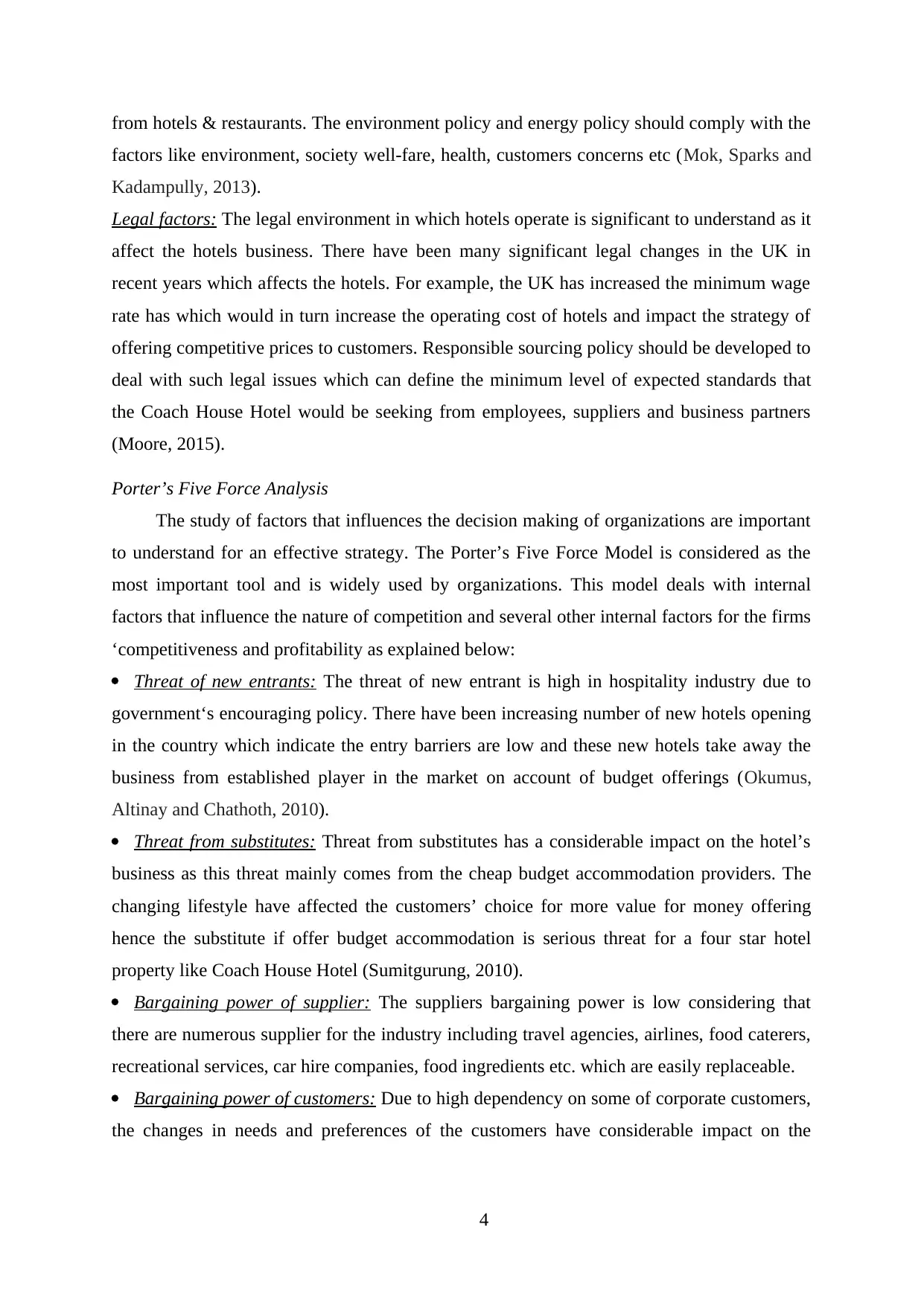
from hotels & restaurants. The environment policy and energy policy should comply with the
factors like environment, society well-fare, health, customers concerns etc (Mok, Sparks and
Kadampully, 2013).
Legal factors: The legal environment in which hotels operate is significant to understand as it
affect the hotels business. There have been many significant legal changes in the UK in
recent years which affects the hotels. For example, the UK has increased the minimum wage
rate has which would in turn increase the operating cost of hotels and impact the strategy of
offering competitive prices to customers. Responsible sourcing policy should be developed to
deal with such legal issues which can define the minimum level of expected standards that
the Coach House Hotel would be seeking from employees, suppliers and business partners
(Moore, 2015).
Porter’s Five Force Analysis
The study of factors that influences the decision making of organizations are important
to understand for an effective strategy. The Porter’s Five Force Model is considered as the
most important tool and is widely used by organizations. This model deals with internal
factors that influence the nature of competition and several other internal factors for the firms
‘competitiveness and profitability as explained below:
Threat of new entrants: The threat of new entrant is high in hospitality industry due to
government‘s encouraging policy. There have been increasing number of new hotels opening
in the country which indicate the entry barriers are low and these new hotels take away the
business from established player in the market on account of budget offerings (Okumus,
Altinay and Chathoth, 2010).
Threat from substitutes: Threat from substitutes has a considerable impact on the hotel’s
business as this threat mainly comes from the cheap budget accommodation providers. The
changing lifestyle have affected the customers’ choice for more value for money offering
hence the substitute if offer budget accommodation is serious threat for a four star hotel
property like Coach House Hotel (Sumitgurung, 2010).
Bargaining power of supplier: The suppliers bargaining power is low considering that
there are numerous supplier for the industry including travel agencies, airlines, food caterers,
recreational services, car hire companies, food ingredients etc. which are easily replaceable.
Bargaining power of customers: Due to high dependency on some of corporate customers,
the changes in needs and preferences of the customers have considerable impact on the
4
factors like environment, society well-fare, health, customers concerns etc (Mok, Sparks and
Kadampully, 2013).
Legal factors: The legal environment in which hotels operate is significant to understand as it
affect the hotels business. There have been many significant legal changes in the UK in
recent years which affects the hotels. For example, the UK has increased the minimum wage
rate has which would in turn increase the operating cost of hotels and impact the strategy of
offering competitive prices to customers. Responsible sourcing policy should be developed to
deal with such legal issues which can define the minimum level of expected standards that
the Coach House Hotel would be seeking from employees, suppliers and business partners
(Moore, 2015).
Porter’s Five Force Analysis
The study of factors that influences the decision making of organizations are important
to understand for an effective strategy. The Porter’s Five Force Model is considered as the
most important tool and is widely used by organizations. This model deals with internal
factors that influence the nature of competition and several other internal factors for the firms
‘competitiveness and profitability as explained below:
Threat of new entrants: The threat of new entrant is high in hospitality industry due to
government‘s encouraging policy. There have been increasing number of new hotels opening
in the country which indicate the entry barriers are low and these new hotels take away the
business from established player in the market on account of budget offerings (Okumus,
Altinay and Chathoth, 2010).
Threat from substitutes: Threat from substitutes has a considerable impact on the hotel’s
business as this threat mainly comes from the cheap budget accommodation providers. The
changing lifestyle have affected the customers’ choice for more value for money offering
hence the substitute if offer budget accommodation is serious threat for a four star hotel
property like Coach House Hotel (Sumitgurung, 2010).
Bargaining power of supplier: The suppliers bargaining power is low considering that
there are numerous supplier for the industry including travel agencies, airlines, food caterers,
recreational services, car hire companies, food ingredients etc. which are easily replaceable.
Bargaining power of customers: Due to high dependency on some of corporate customers,
the changes in needs and preferences of the customers have considerable impact on the
4
⊘ This is a preview!⊘
Do you want full access?
Subscribe today to unlock all pages.

Trusted by 1+ million students worldwide
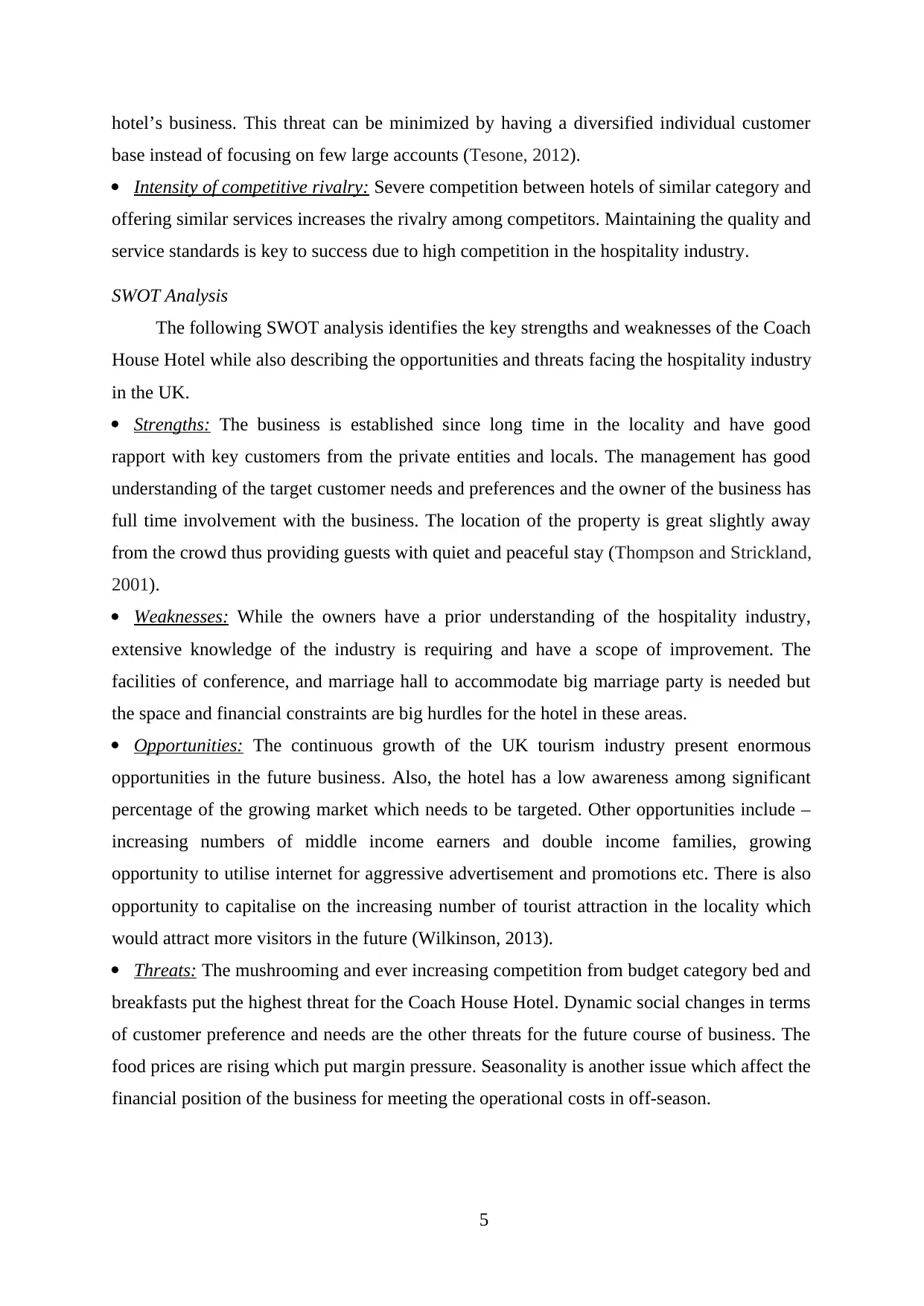
hotel’s business. This threat can be minimized by having a diversified individual customer
base instead of focusing on few large accounts (Tesone, 2012).
Intensity of competitive rivalry: Severe competition between hotels of similar category and
offering similar services increases the rivalry among competitors. Maintaining the quality and
service standards is key to success due to high competition in the hospitality industry.
SWOT Analysis
The following SWOT analysis identifies the key strengths and weaknesses of the Coach
House Hotel while also describing the opportunities and threats facing the hospitality industry
in the UK.
Strengths: The business is established since long time in the locality and have good
rapport with key customers from the private entities and locals. The management has good
understanding of the target customer needs and preferences and the owner of the business has
full time involvement with the business. The location of the property is great slightly away
from the crowd thus providing guests with quiet and peaceful stay (Thompson and Strickland,
2001).
Weaknesses: While the owners have a prior understanding of the hospitality industry,
extensive knowledge of the industry is requiring and have a scope of improvement. The
facilities of conference, and marriage hall to accommodate big marriage party is needed but
the space and financial constraints are big hurdles for the hotel in these areas.
Opportunities: The continuous growth of the UK tourism industry present enormous
opportunities in the future business. Also, the hotel has a low awareness among significant
percentage of the growing market which needs to be targeted. Other opportunities include –
increasing numbers of middle income earners and double income families, growing
opportunity to utilise internet for aggressive advertisement and promotions etc. There is also
opportunity to capitalise on the increasing number of tourist attraction in the locality which
would attract more visitors in the future (Wilkinson, 2013).
Threats: The mushrooming and ever increasing competition from budget category bed and
breakfasts put the highest threat for the Coach House Hotel. Dynamic social changes in terms
of customer preference and needs are the other threats for the future course of business. The
food prices are rising which put margin pressure. Seasonality is another issue which affect the
financial position of the business for meeting the operational costs in off-season.
5
base instead of focusing on few large accounts (Tesone, 2012).
Intensity of competitive rivalry: Severe competition between hotels of similar category and
offering similar services increases the rivalry among competitors. Maintaining the quality and
service standards is key to success due to high competition in the hospitality industry.
SWOT Analysis
The following SWOT analysis identifies the key strengths and weaknesses of the Coach
House Hotel while also describing the opportunities and threats facing the hospitality industry
in the UK.
Strengths: The business is established since long time in the locality and have good
rapport with key customers from the private entities and locals. The management has good
understanding of the target customer needs and preferences and the owner of the business has
full time involvement with the business. The location of the property is great slightly away
from the crowd thus providing guests with quiet and peaceful stay (Thompson and Strickland,
2001).
Weaknesses: While the owners have a prior understanding of the hospitality industry,
extensive knowledge of the industry is requiring and have a scope of improvement. The
facilities of conference, and marriage hall to accommodate big marriage party is needed but
the space and financial constraints are big hurdles for the hotel in these areas.
Opportunities: The continuous growth of the UK tourism industry present enormous
opportunities in the future business. Also, the hotel has a low awareness among significant
percentage of the growing market which needs to be targeted. Other opportunities include –
increasing numbers of middle income earners and double income families, growing
opportunity to utilise internet for aggressive advertisement and promotions etc. There is also
opportunity to capitalise on the increasing number of tourist attraction in the locality which
would attract more visitors in the future (Wilkinson, 2013).
Threats: The mushrooming and ever increasing competition from budget category bed and
breakfasts put the highest threat for the Coach House Hotel. Dynamic social changes in terms
of customer preference and needs are the other threats for the future course of business. The
food prices are rising which put margin pressure. Seasonality is another issue which affect the
financial position of the business for meeting the operational costs in off-season.
5
Paraphrase This Document
Need a fresh take? Get an instant paraphrase of this document with our AI Paraphraser
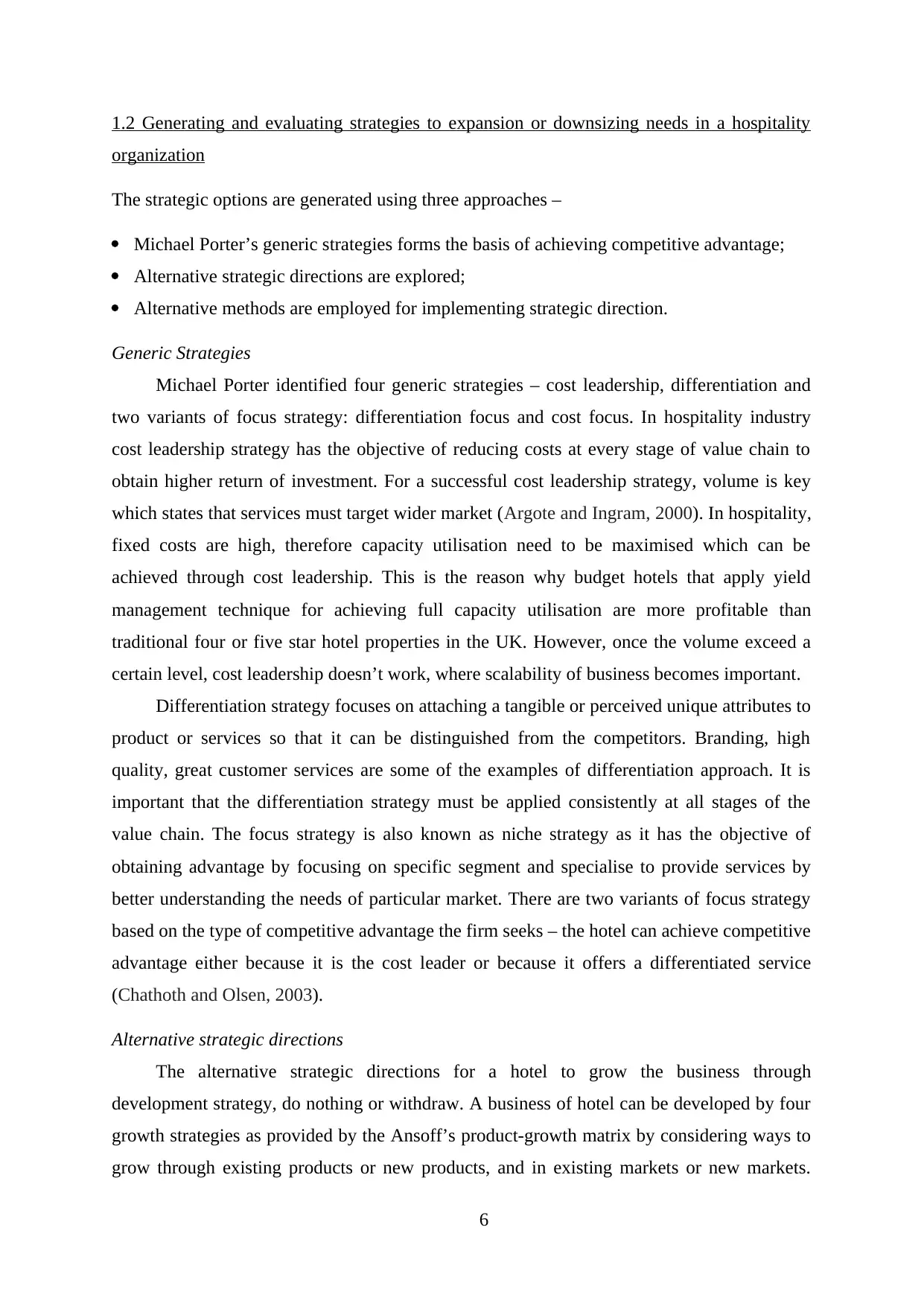
1.2 Generating and evaluating strategies to expansion or downsizing needs in a hospitality
organization
The strategic options are generated using three approaches –
Michael Porter’s generic strategies forms the basis of achieving competitive advantage;
Alternative strategic directions are explored;
Alternative methods are employed for implementing strategic direction.
Generic Strategies
Michael Porter identified four generic strategies – cost leadership, differentiation and
two variants of focus strategy: differentiation focus and cost focus. In hospitality industry
cost leadership strategy has the objective of reducing costs at every stage of value chain to
obtain higher return of investment. For a successful cost leadership strategy, volume is key
which states that services must target wider market (Argote and Ingram, 2000). In hospitality,
fixed costs are high, therefore capacity utilisation need to be maximised which can be
achieved through cost leadership. This is the reason why budget hotels that apply yield
management technique for achieving full capacity utilisation are more profitable than
traditional four or five star hotel properties in the UK. However, once the volume exceed a
certain level, cost leadership doesn’t work, where scalability of business becomes important.
Differentiation strategy focuses on attaching a tangible or perceived unique attributes to
product or services so that it can be distinguished from the competitors. Branding, high
quality, great customer services are some of the examples of differentiation approach. It is
important that the differentiation strategy must be applied consistently at all stages of the
value chain. The focus strategy is also known as niche strategy as it has the objective of
obtaining advantage by focusing on specific segment and specialise to provide services by
better understanding the needs of particular market. There are two variants of focus strategy
based on the type of competitive advantage the firm seeks – the hotel can achieve competitive
advantage either because it is the cost leader or because it offers a differentiated service
(Chathoth and Olsen, 2003).
Alternative strategic directions
The alternative strategic directions for a hotel to grow the business through
development strategy, do nothing or withdraw. A business of hotel can be developed by four
growth strategies as provided by the Ansoff’s product-growth matrix by considering ways to
grow through existing products or new products, and in existing markets or new markets.
6
organization
The strategic options are generated using three approaches –
Michael Porter’s generic strategies forms the basis of achieving competitive advantage;
Alternative strategic directions are explored;
Alternative methods are employed for implementing strategic direction.
Generic Strategies
Michael Porter identified four generic strategies – cost leadership, differentiation and
two variants of focus strategy: differentiation focus and cost focus. In hospitality industry
cost leadership strategy has the objective of reducing costs at every stage of value chain to
obtain higher return of investment. For a successful cost leadership strategy, volume is key
which states that services must target wider market (Argote and Ingram, 2000). In hospitality,
fixed costs are high, therefore capacity utilisation need to be maximised which can be
achieved through cost leadership. This is the reason why budget hotels that apply yield
management technique for achieving full capacity utilisation are more profitable than
traditional four or five star hotel properties in the UK. However, once the volume exceed a
certain level, cost leadership doesn’t work, where scalability of business becomes important.
Differentiation strategy focuses on attaching a tangible or perceived unique attributes to
product or services so that it can be distinguished from the competitors. Branding, high
quality, great customer services are some of the examples of differentiation approach. It is
important that the differentiation strategy must be applied consistently at all stages of the
value chain. The focus strategy is also known as niche strategy as it has the objective of
obtaining advantage by focusing on specific segment and specialise to provide services by
better understanding the needs of particular market. There are two variants of focus strategy
based on the type of competitive advantage the firm seeks – the hotel can achieve competitive
advantage either because it is the cost leader or because it offers a differentiated service
(Chathoth and Olsen, 2003).
Alternative strategic directions
The alternative strategic directions for a hotel to grow the business through
development strategy, do nothing or withdraw. A business of hotel can be developed by four
growth strategies as provided by the Ansoff’s product-growth matrix by considering ways to
grow through existing products or new products, and in existing markets or new markets.
6
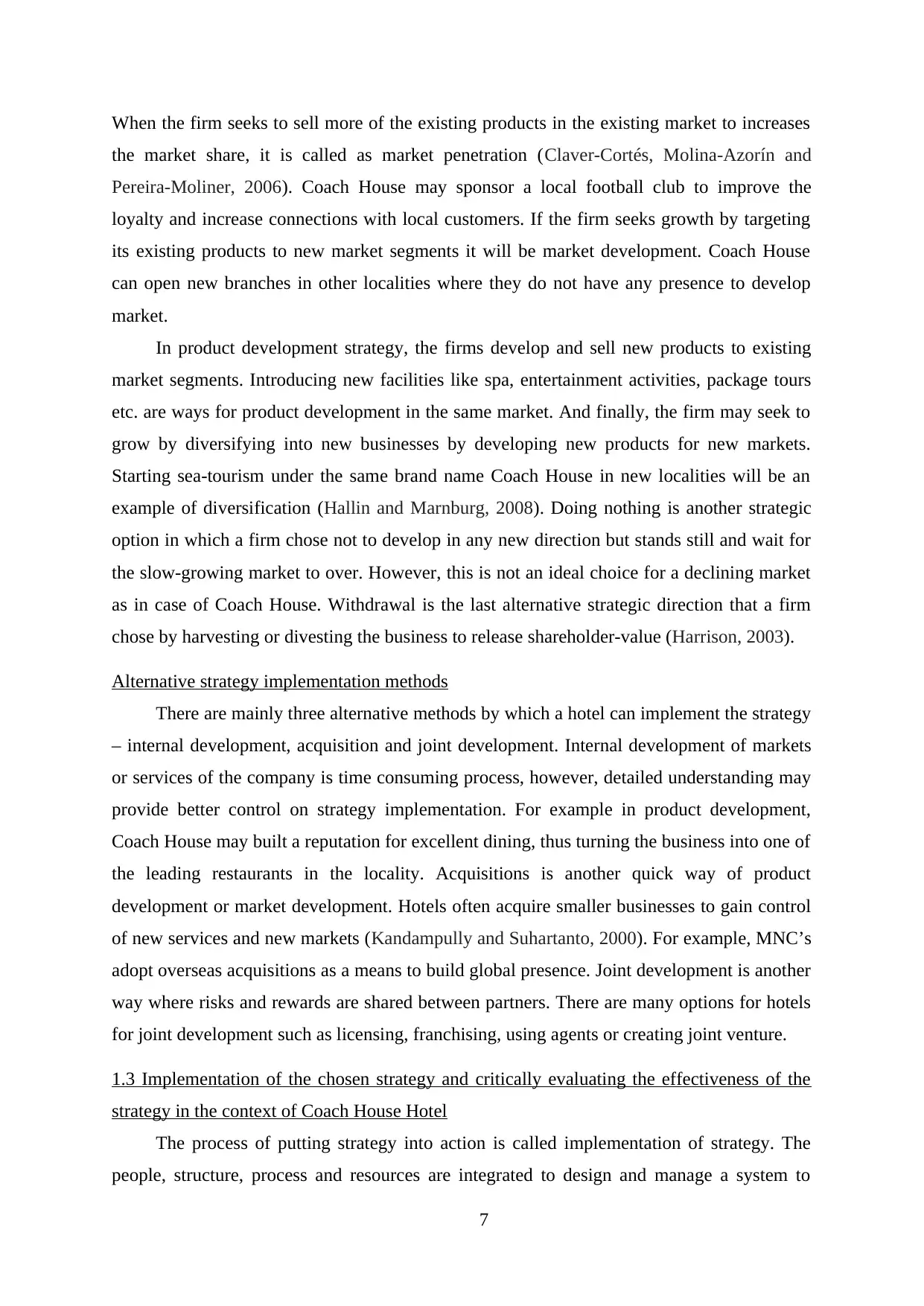
When the firm seeks to sell more of the existing products in the existing market to increases
the market share, it is called as market penetration (Claver-Cortés, Molina-Azorín and
Pereira-Moliner, 2006). Coach House may sponsor a local football club to improve the
loyalty and increase connections with local customers. If the firm seeks growth by targeting
its existing products to new market segments it will be market development. Coach House
can open new branches in other localities where they do not have any presence to develop
market.
In product development strategy, the firms develop and sell new products to existing
market segments. Introducing new facilities like spa, entertainment activities, package tours
etc. are ways for product development in the same market. And finally, the firm may seek to
grow by diversifying into new businesses by developing new products for new markets.
Starting sea-tourism under the same brand name Coach House in new localities will be an
example of diversification (Hallin and Marnburg, 2008). Doing nothing is another strategic
option in which a firm chose not to develop in any new direction but stands still and wait for
the slow-growing market to over. However, this is not an ideal choice for a declining market
as in case of Coach House. Withdrawal is the last alternative strategic direction that a firm
chose by harvesting or divesting the business to release shareholder-value (Harrison, 2003).
Alternative strategy implementation methods
There are mainly three alternative methods by which a hotel can implement the strategy
– internal development, acquisition and joint development. Internal development of markets
or services of the company is time consuming process, however, detailed understanding may
provide better control on strategy implementation. For example in product development,
Coach House may built a reputation for excellent dining, thus turning the business into one of
the leading restaurants in the locality. Acquisitions is another quick way of product
development or market development. Hotels often acquire smaller businesses to gain control
of new services and new markets (Kandampully and Suhartanto, 2000). For example, MNC’s
adopt overseas acquisitions as a means to build global presence. Joint development is another
way where risks and rewards are shared between partners. There are many options for hotels
for joint development such as licensing, franchising, using agents or creating joint venture.
1.3 Implementation of the chosen strategy and critically evaluating the effectiveness of the
strategy in the context of Coach House Hotel
The process of putting strategy into action is called implementation of strategy. The
people, structure, process and resources are integrated to design and manage a system to
7
the market share, it is called as market penetration (Claver-Cortés, Molina-Azorín and
Pereira-Moliner, 2006). Coach House may sponsor a local football club to improve the
loyalty and increase connections with local customers. If the firm seeks growth by targeting
its existing products to new market segments it will be market development. Coach House
can open new branches in other localities where they do not have any presence to develop
market.
In product development strategy, the firms develop and sell new products to existing
market segments. Introducing new facilities like spa, entertainment activities, package tours
etc. are ways for product development in the same market. And finally, the firm may seek to
grow by diversifying into new businesses by developing new products for new markets.
Starting sea-tourism under the same brand name Coach House in new localities will be an
example of diversification (Hallin and Marnburg, 2008). Doing nothing is another strategic
option in which a firm chose not to develop in any new direction but stands still and wait for
the slow-growing market to over. However, this is not an ideal choice for a declining market
as in case of Coach House. Withdrawal is the last alternative strategic direction that a firm
chose by harvesting or divesting the business to release shareholder-value (Harrison, 2003).
Alternative strategy implementation methods
There are mainly three alternative methods by which a hotel can implement the strategy
– internal development, acquisition and joint development. Internal development of markets
or services of the company is time consuming process, however, detailed understanding may
provide better control on strategy implementation. For example in product development,
Coach House may built a reputation for excellent dining, thus turning the business into one of
the leading restaurants in the locality. Acquisitions is another quick way of product
development or market development. Hotels often acquire smaller businesses to gain control
of new services and new markets (Kandampully and Suhartanto, 2000). For example, MNC’s
adopt overseas acquisitions as a means to build global presence. Joint development is another
way where risks and rewards are shared between partners. There are many options for hotels
for joint development such as licensing, franchising, using agents or creating joint venture.
1.3 Implementation of the chosen strategy and critically evaluating the effectiveness of the
strategy in the context of Coach House Hotel
The process of putting strategy into action is called implementation of strategy. The
people, structure, process and resources are integrated to design and manage a system to
7
⊘ This is a preview!⊘
Do you want full access?
Subscribe today to unlock all pages.

Trusted by 1+ million students worldwide
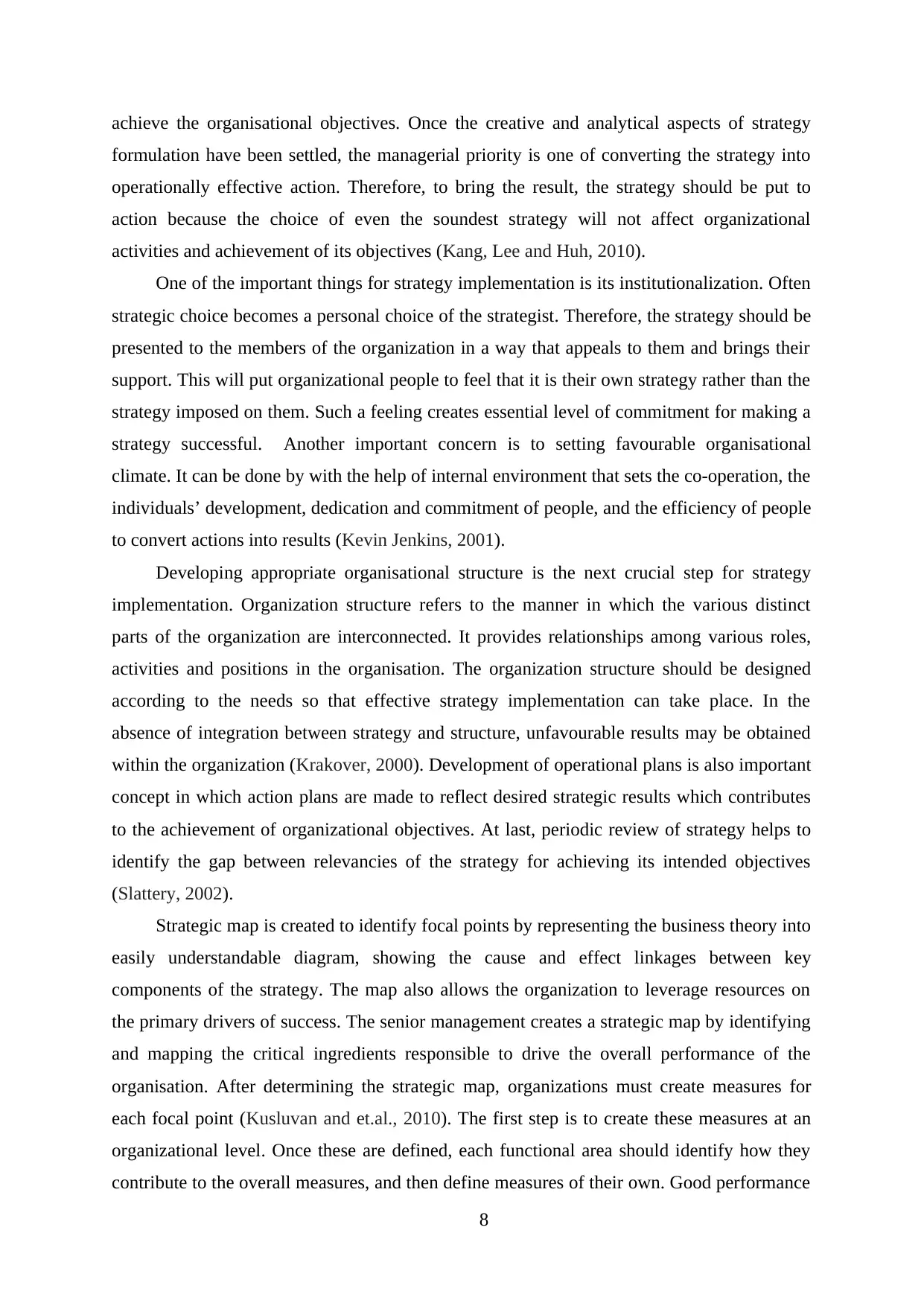
achieve the organisational objectives. Once the creative and analytical aspects of strategy
formulation have been settled, the managerial priority is one of converting the strategy into
operationally effective action. Therefore, to bring the result, the strategy should be put to
action because the choice of even the soundest strategy will not affect organizational
activities and achievement of its objectives (Kang, Lee and Huh, 2010).
One of the important things for strategy implementation is its institutionalization. Often
strategic choice becomes a personal choice of the strategist. Therefore, the strategy should be
presented to the members of the organization in a way that appeals to them and brings their
support. This will put organizational people to feel that it is their own strategy rather than the
strategy imposed on them. Such a feeling creates essential level of commitment for making a
strategy successful. Another important concern is to setting favourable organisational
climate. It can be done by with the help of internal environment that sets the co-operation, the
individuals’ development, dedication and commitment of people, and the efficiency of people
to convert actions into results (Kevin Jenkins, 2001).
Developing appropriate organisational structure is the next crucial step for strategy
implementation. Organization structure refers to the manner in which the various distinct
parts of the organization are interconnected. It provides relationships among various roles,
activities and positions in the organisation. The organization structure should be designed
according to the needs so that effective strategy implementation can take place. In the
absence of integration between strategy and structure, unfavourable results may be obtained
within the organization (Krakover, 2000). Development of operational plans is also important
concept in which action plans are made to reflect desired strategic results which contributes
to the achievement of organizational objectives. At last, periodic review of strategy helps to
identify the gap between relevancies of the strategy for achieving its intended objectives
(Slattery, 2002).
Strategic map is created to identify focal points by representing the business theory into
easily understandable diagram, showing the cause and effect linkages between key
components of the strategy. The map also allows the organization to leverage resources on
the primary drivers of success. The senior management creates a strategic map by identifying
and mapping the critical ingredients responsible to drive the overall performance of the
organisation. After determining the strategic map, organizations must create measures for
each focal point (Kusluvan and et.al., 2010). The first step is to create these measures at an
organizational level. Once these are defined, each functional area should identify how they
contribute to the overall measures, and then define measures of their own. Good performance
8
formulation have been settled, the managerial priority is one of converting the strategy into
operationally effective action. Therefore, to bring the result, the strategy should be put to
action because the choice of even the soundest strategy will not affect organizational
activities and achievement of its objectives (Kang, Lee and Huh, 2010).
One of the important things for strategy implementation is its institutionalization. Often
strategic choice becomes a personal choice of the strategist. Therefore, the strategy should be
presented to the members of the organization in a way that appeals to them and brings their
support. This will put organizational people to feel that it is their own strategy rather than the
strategy imposed on them. Such a feeling creates essential level of commitment for making a
strategy successful. Another important concern is to setting favourable organisational
climate. It can be done by with the help of internal environment that sets the co-operation, the
individuals’ development, dedication and commitment of people, and the efficiency of people
to convert actions into results (Kevin Jenkins, 2001).
Developing appropriate organisational structure is the next crucial step for strategy
implementation. Organization structure refers to the manner in which the various distinct
parts of the organization are interconnected. It provides relationships among various roles,
activities and positions in the organisation. The organization structure should be designed
according to the needs so that effective strategy implementation can take place. In the
absence of integration between strategy and structure, unfavourable results may be obtained
within the organization (Krakover, 2000). Development of operational plans is also important
concept in which action plans are made to reflect desired strategic results which contributes
to the achievement of organizational objectives. At last, periodic review of strategy helps to
identify the gap between relevancies of the strategy for achieving its intended objectives
(Slattery, 2002).
Strategic map is created to identify focal points by representing the business theory into
easily understandable diagram, showing the cause and effect linkages between key
components of the strategy. The map also allows the organization to leverage resources on
the primary drivers of success. The senior management creates a strategic map by identifying
and mapping the critical ingredients responsible to drive the overall performance of the
organisation. After determining the strategic map, organizations must create measures for
each focal point (Kusluvan and et.al., 2010). The first step is to create these measures at an
organizational level. Once these are defined, each functional area should identify how they
contribute to the overall measures, and then define measures of their own. Good performance
8
Paraphrase This Document
Need a fresh take? Get an instant paraphrase of this document with our AI Paraphraser
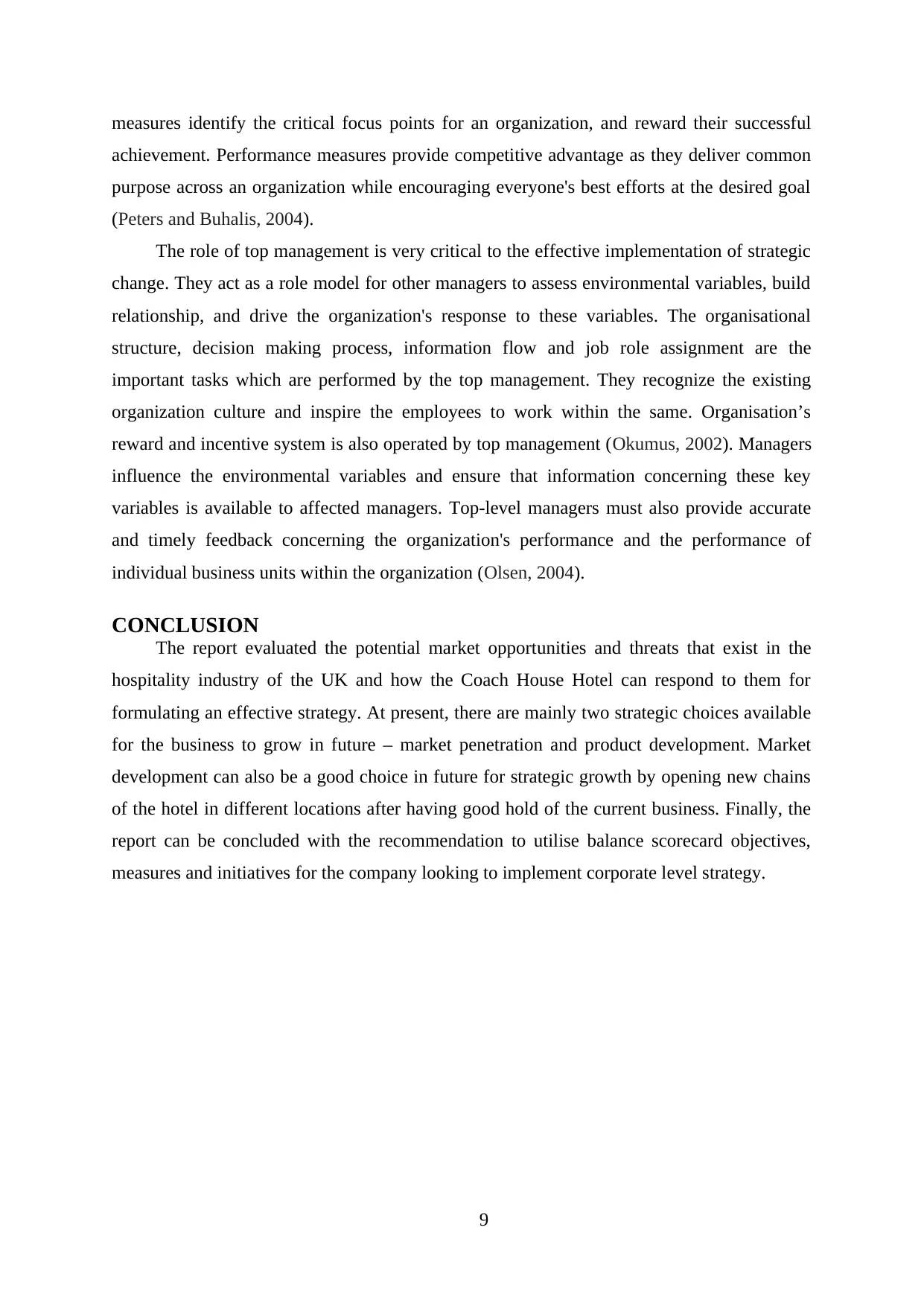
measures identify the critical focus points for an organization, and reward their successful
achievement. Performance measures provide competitive advantage as they deliver common
purpose across an organization while encouraging everyone's best efforts at the desired goal
(Peters and Buhalis, 2004).
The role of top management is very critical to the effective implementation of strategic
change. They act as a role model for other managers to assess environmental variables, build
relationship, and drive the organization's response to these variables. The organisational
structure, decision making process, information flow and job role assignment are the
important tasks which are performed by the top management. They recognize the existing
organization culture and inspire the employees to work within the same. Organisation’s
reward and incentive system is also operated by top management (Okumus, 2002). Managers
influence the environmental variables and ensure that information concerning these key
variables is available to affected managers. Top-level managers must also provide accurate
and timely feedback concerning the organization's performance and the performance of
individual business units within the organization (Olsen, 2004).
CONCLUSION
The report evaluated the potential market opportunities and threats that exist in the
hospitality industry of the UK and how the Coach House Hotel can respond to them for
formulating an effective strategy. At present, there are mainly two strategic choices available
for the business to grow in future – market penetration and product development. Market
development can also be a good choice in future for strategic growth by opening new chains
of the hotel in different locations after having good hold of the current business. Finally, the
report can be concluded with the recommendation to utilise balance scorecard objectives,
measures and initiatives for the company looking to implement corporate level strategy.
9
achievement. Performance measures provide competitive advantage as they deliver common
purpose across an organization while encouraging everyone's best efforts at the desired goal
(Peters and Buhalis, 2004).
The role of top management is very critical to the effective implementation of strategic
change. They act as a role model for other managers to assess environmental variables, build
relationship, and drive the organization's response to these variables. The organisational
structure, decision making process, information flow and job role assignment are the
important tasks which are performed by the top management. They recognize the existing
organization culture and inspire the employees to work within the same. Organisation’s
reward and incentive system is also operated by top management (Okumus, 2002). Managers
influence the environmental variables and ensure that information concerning these key
variables is available to affected managers. Top-level managers must also provide accurate
and timely feedback concerning the organization's performance and the performance of
individual business units within the organization (Olsen, 2004).
CONCLUSION
The report evaluated the potential market opportunities and threats that exist in the
hospitality industry of the UK and how the Coach House Hotel can respond to them for
formulating an effective strategy. At present, there are mainly two strategic choices available
for the business to grow in future – market penetration and product development. Market
development can also be a good choice in future for strategic growth by opening new chains
of the hotel in different locations after having good hold of the current business. Finally, the
report can be concluded with the recommendation to utilise balance scorecard objectives,
measures and initiatives for the company looking to implement corporate level strategy.
9
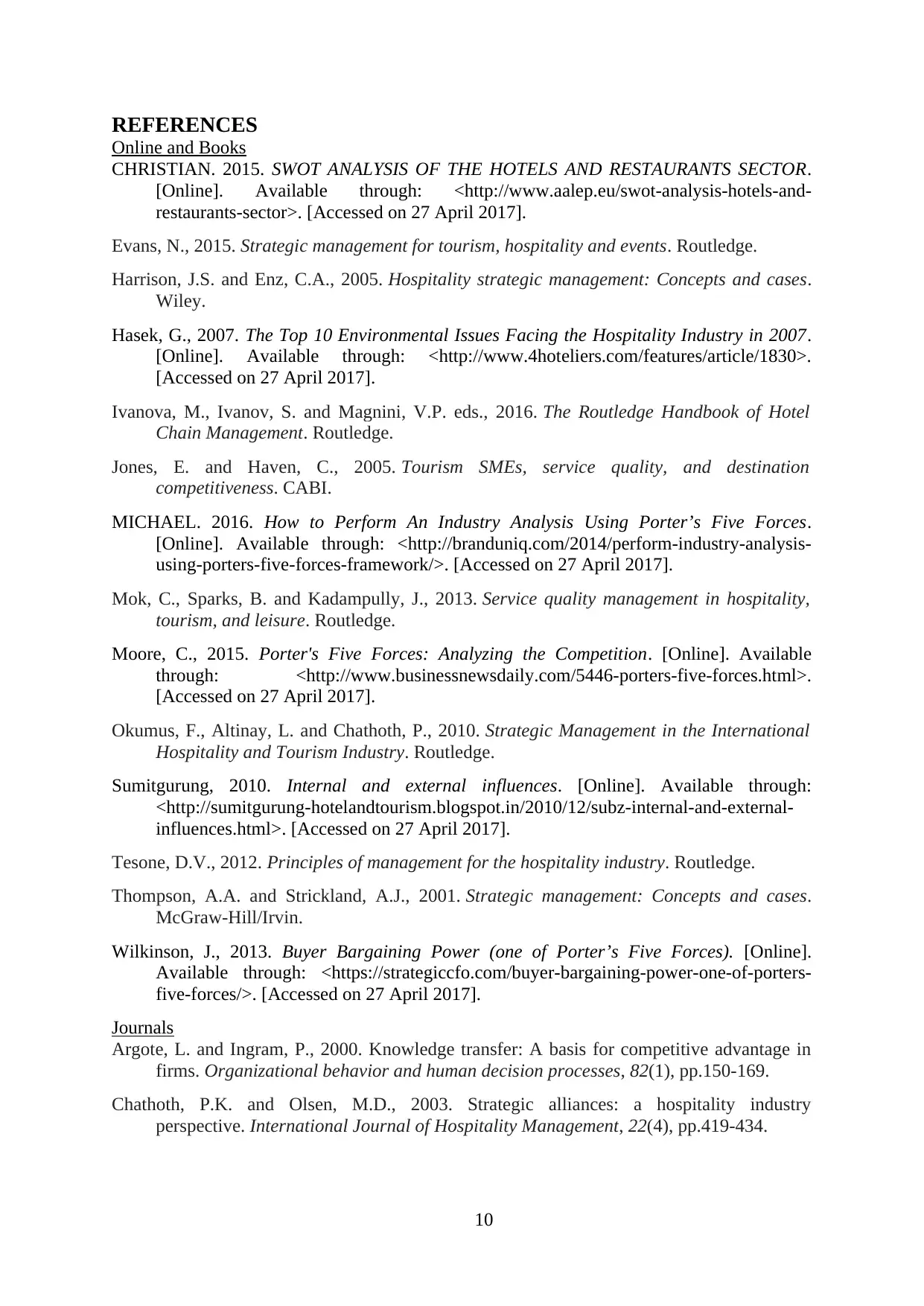
REFERENCES
Online and Books
CHRISTIAN. 2015. SWOT ANALYSIS OF THE HOTELS AND RESTAURANTS SECTOR.
[Online]. Available through: <http://www.aalep.eu/swot-analysis-hotels-and-
restaurants-sector>. [Accessed on 27 April 2017].
Evans, N., 2015. Strategic management for tourism, hospitality and events. Routledge.
Harrison, J.S. and Enz, C.A., 2005. Hospitality strategic management: Concepts and cases.
Wiley.
Hasek, G., 2007. The Top 10 Environmental Issues Facing the Hospitality Industry in 2007.
[Online]. Available through: <http://www.4hoteliers.com/features/article/1830>.
[Accessed on 27 April 2017].
Ivanova, M., Ivanov, S. and Magnini, V.P. eds., 2016. The Routledge Handbook of Hotel
Chain Management. Routledge.
Jones, E. and Haven, C., 2005. Tourism SMEs, service quality, and destination
competitiveness. CABI.
MICHAEL. 2016. How to Perform An Industry Analysis Using Porter’s Five Forces.
[Online]. Available through: <http://branduniq.com/2014/perform-industry-analysis-
using-porters-five-forces-framework/>. [Accessed on 27 April 2017].
Mok, C., Sparks, B. and Kadampully, J., 2013. Service quality management in hospitality,
tourism, and leisure. Routledge.
Moore, C., 2015. Porter's Five Forces: Analyzing the Competition. [Online]. Available
through: <http://www.businessnewsdaily.com/5446-porters-five-forces.html>.
[Accessed on 27 April 2017].
Okumus, F., Altinay, L. and Chathoth, P., 2010. Strategic Management in the International
Hospitality and Tourism Industry. Routledge.
Sumitgurung, 2010. Internal and external influences. [Online]. Available through:
<http://sumitgurung-hotelandtourism.blogspot.in/2010/12/subz-internal-and-external-
influences.html>. [Accessed on 27 April 2017].
Tesone, D.V., 2012. Principles of management for the hospitality industry. Routledge.
Thompson, A.A. and Strickland, A.J., 2001. Strategic management: Concepts and cases.
McGraw-Hill/Irvin.
Wilkinson, J., 2013. Buyer Bargaining Power (one of Porter’s Five Forces). [Online].
Available through: <https://strategiccfo.com/buyer-bargaining-power-one-of-porters-
five-forces/>. [Accessed on 27 April 2017].
Journals
Argote, L. and Ingram, P., 2000. Knowledge transfer: A basis for competitive advantage in
firms. Organizational behavior and human decision processes, 82(1), pp.150-169.
Chathoth, P.K. and Olsen, M.D., 2003. Strategic alliances: a hospitality industry
perspective. International Journal of Hospitality Management, 22(4), pp.419-434.
10
Online and Books
CHRISTIAN. 2015. SWOT ANALYSIS OF THE HOTELS AND RESTAURANTS SECTOR.
[Online]. Available through: <http://www.aalep.eu/swot-analysis-hotels-and-
restaurants-sector>. [Accessed on 27 April 2017].
Evans, N., 2015. Strategic management for tourism, hospitality and events. Routledge.
Harrison, J.S. and Enz, C.A., 2005. Hospitality strategic management: Concepts and cases.
Wiley.
Hasek, G., 2007. The Top 10 Environmental Issues Facing the Hospitality Industry in 2007.
[Online]. Available through: <http://www.4hoteliers.com/features/article/1830>.
[Accessed on 27 April 2017].
Ivanova, M., Ivanov, S. and Magnini, V.P. eds., 2016. The Routledge Handbook of Hotel
Chain Management. Routledge.
Jones, E. and Haven, C., 2005. Tourism SMEs, service quality, and destination
competitiveness. CABI.
MICHAEL. 2016. How to Perform An Industry Analysis Using Porter’s Five Forces.
[Online]. Available through: <http://branduniq.com/2014/perform-industry-analysis-
using-porters-five-forces-framework/>. [Accessed on 27 April 2017].
Mok, C., Sparks, B. and Kadampully, J., 2013. Service quality management in hospitality,
tourism, and leisure. Routledge.
Moore, C., 2015. Porter's Five Forces: Analyzing the Competition. [Online]. Available
through: <http://www.businessnewsdaily.com/5446-porters-five-forces.html>.
[Accessed on 27 April 2017].
Okumus, F., Altinay, L. and Chathoth, P., 2010. Strategic Management in the International
Hospitality and Tourism Industry. Routledge.
Sumitgurung, 2010. Internal and external influences. [Online]. Available through:
<http://sumitgurung-hotelandtourism.blogspot.in/2010/12/subz-internal-and-external-
influences.html>. [Accessed on 27 April 2017].
Tesone, D.V., 2012. Principles of management for the hospitality industry. Routledge.
Thompson, A.A. and Strickland, A.J., 2001. Strategic management: Concepts and cases.
McGraw-Hill/Irvin.
Wilkinson, J., 2013. Buyer Bargaining Power (one of Porter’s Five Forces). [Online].
Available through: <https://strategiccfo.com/buyer-bargaining-power-one-of-porters-
five-forces/>. [Accessed on 27 April 2017].
Journals
Argote, L. and Ingram, P., 2000. Knowledge transfer: A basis for competitive advantage in
firms. Organizational behavior and human decision processes, 82(1), pp.150-169.
Chathoth, P.K. and Olsen, M.D., 2003. Strategic alliances: a hospitality industry
perspective. International Journal of Hospitality Management, 22(4), pp.419-434.
10
⊘ This is a preview!⊘
Do you want full access?
Subscribe today to unlock all pages.

Trusted by 1+ million students worldwide
1 out of 13
Related Documents
Your All-in-One AI-Powered Toolkit for Academic Success.
+13062052269
info@desklib.com
Available 24*7 on WhatsApp / Email
![[object Object]](/_next/static/media/star-bottom.7253800d.svg)
Unlock your academic potential
Copyright © 2020–2025 A2Z Services. All Rights Reserved. Developed and managed by ZUCOL.




